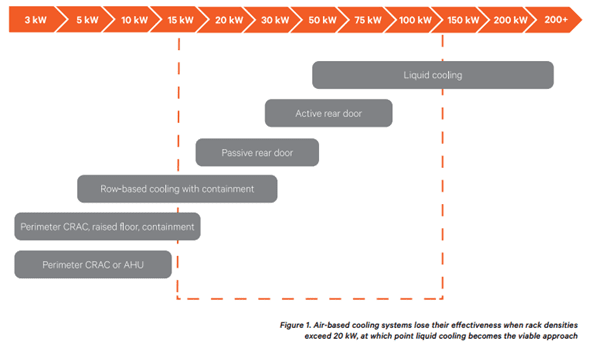TL;DR:
- Liquid cooling is a compelling solution for addressing the heat-related challenges of AI infrastructure and high-density computing.
- The liquid cooling market is projected to exceed $3 billion by 2026, with a shift towards a combination of air-cooled and liquid-cooled systems in data centers.
- Rear-door heat exchangers (RDHx) offer a non-disruptive way to introduce liquid cooling without additional floor space requirements.
- RDHx systems provide room-neutral cooling, reducing strain on perimeter cooling units.
- Direct-to-chip and immersion cooling are specialized solutions for non-retrofitted liquid cooling deployments.
- Liquid cooling offers higher efficiency, greater rack density, and improved cooling performance compared to air cooling.
- Careful design and implementation can mitigate risks associated with liquid cooling, such as leaks or hardware failures.
- Liquid cooling enhances overall energy efficiency, reduces power consumption, and lowers operating costs.
- Liquid cooling enables denser rack configurations, maximizing space utilization and computing power.
- Superior cooling performance of liquid cooling ensures optimal temperature ranges, minimizing performance issues and hardware failures.
Main AI News:
The disruptive potential of generative artificial intelligence (AI) and its implications for the data center industry have been generating considerable buzz and discussion. If you’ve been following the latest articles or perusing the pages of DCD’s magazine, you’re likely familiar with the demands that AI infrastructure places on our computing facilities. As AI continues to gain traction, the projected surge in demand will exceed even the most optimistic forecasts for compute densities.
The computational power required by AI applications inevitably leads to heightened power consumption, resulting in the generation of substantial amounts of heat. Failure to effectively manage this heat can lead to performance issues and hardware failures. For facility operation teams seeking to deploy high-density solutions for emerging technologies such as AI, low-latency streaming, or gaming, tackling the challenge of thermal management becomes paramount.
When examining the infrastructure necessary for high-performance compute deployments driven by generative AI, it becomes evident that liquid cooling systems present a compelling solution for addressing the heat-related issues that air cooling struggles to manage efficiently. According to Omdia’s 2022 Data Center Liquid Cooling Market Analysis report, the liquid cooling market is projected to surpass $3 billion by 2026. The report also predicts that a combination of air-cooled and liquid-cooled systems will become the norm in data centers in the near future.
With AI becoming an increasingly prominent topic among the average consumer, companies considering the integration of emerging technologies into their operations stand to benefit from exploring the liquid cooling options available today that can seamlessly scale to meet tomorrow’s demands.
Currently, most liquid cooling deployments involve retrofitting existing server racks in air-cooled facilities, with solutions like rear-door heat exchangers (RDHx) leading the way. RDHx systems, which take up no additional floor space in the data center, offer an excellent means of introducing liquid cooling architecture without the need for a complete overhaul of the white space.
RDHx configurations leverage different cooling mediums, such as refrigerant-based, chilled water, or glycol, and utilize either passive or active cooling fans to draw air through the heat exchange coil. Implementing this technology in the data center also provides a room-neutral cooling solution, ensuring that the air temperature leaving the RDHx aligns closely with the ambient room temperature. This reduces strain on perimeter cooling units.
For data centers looking to accommodate higher-density racks and embrace liquid cooling as they scale, RDHx systems are an ideal solution. By starting with a passive rear door today, organizations can lay the foundation for accommodating higher densities in the future.
While RDHx systems offer an entry point into liquid cooling, some organizations seek more specialized solutions for their clusters. When exploring configuration options for non-retrofitted liquid cooling deployments, two primary approaches come into focus: immersion cooling and direct-to-chip cooling.
Direct-to-chip liquid cooling revolves around a design that directly connects a cold plate to high-heat components, such as CPUs, GPUs, memory modules, and power supplies. By leveraging single-phase cold plates or two-phase fluids, this cooling method can effectively dissipate around 70-75 percent of the heat generated by the equipment in a rack, with the remaining 25-30 percent easily managed by air-cooling systems.
On the other hand, immersion cooling represents a promising technology that can remove 100 percent of the heat through a liquid. While dealing with dielectric fluids introduces complexities, immersion cooling offers a radically different approach to cooling compared to traditional air-cooling methods. Single-phase and two-phase immersion cooling systems submerge servers and rack components in a thermally conductive dielectric liquid or fluid, significantly reducing reliance on air cooling.
Liquid cooling is emerging as a transformative solution in the data center industry, offering significant advantages over traditional air cooling methods. As the demands of generative AI and other emerging technologies continue to push the limits of compute densities, data center operators must embrace innovative thermal management systems to stay competitive.
While there are challenges associated with liquid cooling, such as the potential risk of leaks or hardware failures, these concerns can be mitigated through careful design and implementation. By adopting best practices and robust engineering techniques, data centers can minimize these risks and fully reap the benefits of liquid cooling.
One of the primary advantages of liquid cooling is its ability to deliver higher efficiency compared to air cooling. Liquid cooling systems have a superior heat dissipation capability, allowing for more effective removal of heat from critical hardware components. This enhanced cooling performance translates into improved overall energy efficiency, reducing power consumption and operating costs.
Another key benefit of liquid cooling is its capacity to accommodate greater rack density. As compute requirements continue to soar, data centers must maximize their available space to house an increasing number of servers and equipment. Liquid cooling enables denser rack configurations by efficiently removing heat and eliminating the constraints imposed by air-cooling methods. This increased rack density translates into higher computing power within the same physical footprint.
Furthermore, liquid cooling provides superior cooling performance, ensuring that critical hardware operates within optimal temperature ranges. By efficiently dissipating heat, liquid cooling mitigates performance issues and minimizes the risk of IT device hardware failure. This improved reliability and longevity of hardware assets contribute to uninterrupted operations and enhanced productivity.

Source: DCD
Conlcusion:
The growing adoption of liquid cooling technology in the data center industry, driven by the demands of generative AI and emerging technologies, is poised to reshape the market landscape. The projected market growth of over $3 billion by 2026, coupled with the increasing shift towards a combination of air-cooled and liquid-cooled systems, signifies a significant market opportunity for liquid cooling providers.
The advantages of higher efficiency, greater rack density, and improved cooling performance position liquid cooling as a transformative solution for data center operators seeking to optimize their operations and stay competitive in an evolving technological landscape. As organizations strive to meet the escalating compute densities and cooling demands, embracing liquid cooling as a vital component of their infrastructure strategy will be essential for success in the market.

